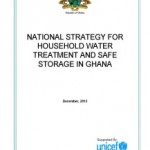Ghana National Strategy for Household Water Treatment by Ryan Rowe | Source-Feb 28, 2013 |
Good news from West Africa! The Government of Ghana is making further progress on its “National Strategy on Household Water Treatment and Safe Storage”. This follows a series of efforts since 2010, which included an assessment commissioned by UNICEF, an initial draft to kick off the strategy development process, and several stakeholder consultations, including one in June 2012. This is an important step to empowering households to improve the quality of their drinking water, in a country where as many as 5 million people are at risk of water-related diseases from the simple act of quenching their thirst. Now, the government plans another regional workshop and is seeking additional input to make the strategy as focused and effective as possible. As part of my work with the International Network on Household Water Treatment and Safe Storage, I’ll have an opportunity to provide input to their plans over the next few months. 
For those unfamiliar with the practice, household [or, point-of-use] water treatment and safe storage (HWTS) involves the application of technologies or techniques to improve the quality of drinking water in the home, or other places where water is consumed, such as schools and health clinics. Many may think of boiling when they think of water purification. Although boiling is effective if done properly, but it can also be expensive and sometimes causes other health problems, such as injuries from burns, or lead to respiratory infections if the water is boiled over an open (and smoky) fire inside the home. Other popular techniques of water purification include adding chlorine, using a filter and even solar disinfection. The “safe storage” part of HWTS comes from keeping water in clean, covered containers to makes sure it stays safe and does not get re-contaminated by dirty flies or fingers in places they shouldn’t be.
Many firms (for-profit, non-profit and social enterprise) around the world have come up with solutions to purify dirty drinking water. Some such companies include Procter & Gamble (P&G Purifier of Water),Vestergaard-Frandsen (the LifeStraw), Basic Water Needs (the Tulip Filter) and Ecofiltro.
In countries where not everyone has access to tap water, there are real concerns about the quality of drinking water. For example, in Ghana, about 9% of people living in cities draw water from surface sources such as lakes, ponds or unprotected wells or boreholes (JMP, 2012). In rural areas, it is much worse: about 31% of people draw water from such sources (JMP, 2012). Nationwide, that means about 5 million people (20% of the population) drink water from sources considered unsafe.
Drinking contaminated water often leads to killer diseases, the brunt of which is borne by children. In Ghana, about 7% of all deaths in children under five years old are due to diarrhoea (A Promise Renewed, 2012). Published research has shown that HWTS can reduce the incidence of diarrhoea by up to 47% (Fewtrell et al, 2005; Clasen et al, 2006; Waddington et al, 2009). Although child mortality in many Sub-Saharan African countries has declined in recent years, it remains too high.
When I first began learning more about the water crisis years ago, it struck me as incredible that hundreds of thousands (at least) of children die every year from preventable diarrhoea. Working on improving child survival has become one of my life’s passions and was the reason for why I re-focused my career on learning about and supporting efforts to increase access to safe water through methods such as HWTS.
Stay tuned to this page for more updates on Ghana’s progress in the coming months!




{ 1 comment… read it below or add one }
We are operating from Tema using the Hydraid Biosand Filter from Triple Quest (Grand Rapids, MI).
Let us know how we can participate!